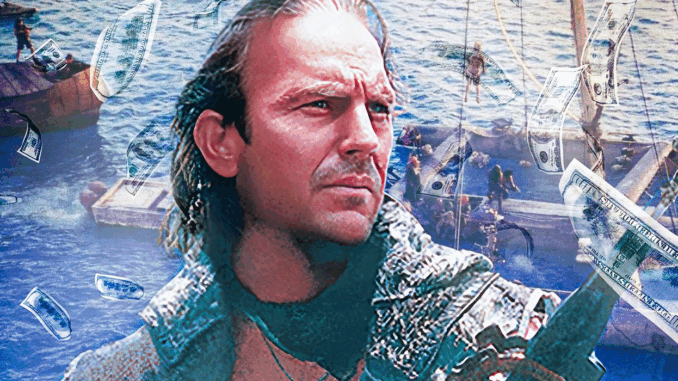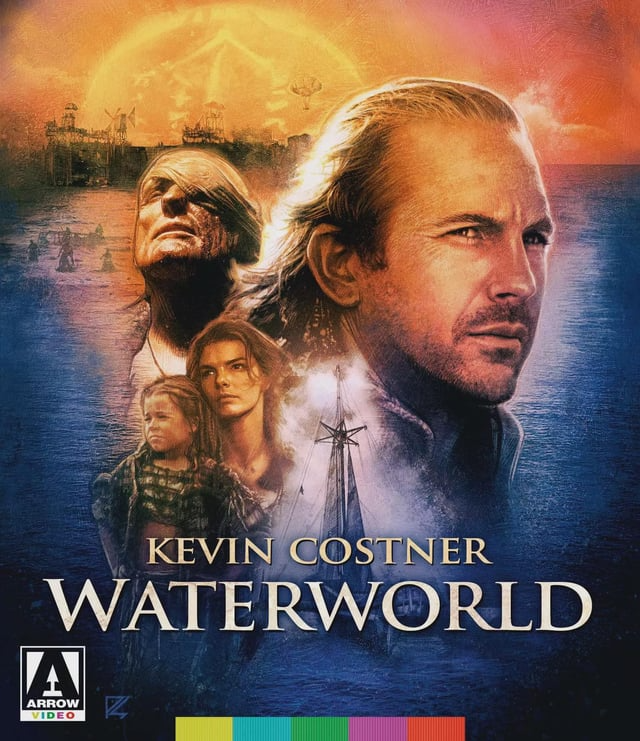
When Kevin Costner produced and starred in Waterworld in 1995, few anticipated the massive production nightmare it would become. What was meant to be a groundbreaking post-apocalyptic epic instead turned into one of the most talked-about disasters in Hollywood history. With a gargantuan budget reportedly topping $175 million and a slew of production problems, Waterworld initially sank under harsh critical reviews and box office disappointment.
But is the story really that simple? How did Waterworld go from being a symbol of Hollywood excess to a cult favorite? And what did it mean for Costner’s career?
Let’s dive into the turbulent journey of Waterworld—from its ambitious beginnings to its legacy today.
1. The Vision Behind Waterworld
Kevin Costner wasn’t just acting; he wanted to create a cinematic spectacle that pushed boundaries. Set in a flooded future where the polar ice caps have melted, Waterworld promised breathtaking visuals and a unique storyline. Costner’s passion project had all the ingredients to be a blockbuster.
2. Why Produce and Star? Costner’s Risky Move
Taking on dual roles as lead actor and producer, Costner invested heavily—both creatively and financially. His confidence in the project was huge, but so was the gamble. Few actors take this much control over a big-budget film, especially a sci-fi epic.
3. Budget Overruns: How $175 Million Was Spent
Originally budgeted at around $100 million, Waterworld’s costs skyrocketed. The $175 million final tab shocked the industry, making it the most expensive film at that time. Why? Sets built on water, elaborate stunts, and technical challenges all drove costs through the roof.
4. Production Woes: Weather, Sets, and Chaos
One of the biggest headaches was filming on open water, mainly off the coast of Hawaii. Severe weather delays—think tropical storms and choppy seas—caused repeated shutdowns. Massive floating sets were damaged or destroyed, requiring costly rebuilds. It was a logistical nightmare.
5. The Cast and Crew Under Pressure
Tensions ran high on set. Extended delays meant morale dipped, budgets stretched thin, and pressure mounted on everyone—from Costner down to the crew. Rumors of friction surfaced, but many persevered, believing in the film’s potential.
6. Marketing and Public Expectations
With such a massive budget, expectations soared. The marketing machine hyped Waterworld as the next big summer blockbuster. Trailers showed thrilling water battles and a mysterious drifter hero, but audiences were unsure what to expect.
7. The Premiere and Initial Critical Reception
When Waterworld finally hit theaters, critics were brutal. Many panned the story’s weak script, uneven pacing, and confusing plot. While the visual effects received praise, it wasn’t enough to save the film’s reputation.
8. Public Reaction: Mockery and Memes Before Their Time
Audiences didn’t just ignore Waterworld—they mocked it. Jokes about the “Kevin Costner’s bathtub movie” circulated widely. It became a punchline for Hollywood’s extravagance gone wrong.
9. Box Office Performance: Flop or Financial Disaster?
Although Waterworld grossed over $260 million worldwide, the inflated production and marketing costs meant it barely broke even. Studios considered it a financial disappointment, and the stigma of “flop” stuck.

10. How Waterworld Hurt Kevin Costner’s Career
The film’s failure dented Costner’s standing as a filmmaker. After years of critical acclaim and hits like Dances with Wolves, Waterworld raised questions about his decision-making and box office appeal.
11. Cult Status: The Movie That Refused to Sink
Despite initial backlash, Waterworld gradually earned a cult following. Fans appreciated its ambitious visuals and unique world-building. It became a staple of late-night cable TV and DVD collections.
12. Lessons Learned: Hollywood’s Takeaways From Waterworld
Waterworld remains a cautionary tale about uncontrolled budgets, risky production choices, and the challenges of filmmaking on water. Studios took note to better manage future blockbusters.
13. Technical Innovations: Pushing Visual Effects Boundaries
The movie did break new ground technically. Its elaborate water sets and stunt work influenced later films. Some effects still hold up, showing that ambition sometimes leads to innovation.
14. Behind the Scenes: Stories From the Set
Many cast and crew members have since shared wild stories about the tough filming conditions—rising seas, damaged props, and Costner’s leadership. These anecdotes keep the film’s legacy alive.
15. Kevin Costner Today: How He Looks Back on Waterworld
In interviews, Costner reflects on Waterworld with a mix of pride and humility. He acknowledges mistakes but stands by the boldness of the project, calling it an unforgettable experience that shaped his career.
Conclusion: Waterworld — A Risky Voyage That Left a Lasting Mark
Waterworld might have sunk at the box office and in critics’ eyes, but it wasn’t just a failure—it was a bold experiment. Kevin Costner’s passion project became a Hollywood legend for all the wrong reasons at first, yet over time it has found its place as a cult classic. The story of Waterworld is a perfect storm of ambition, risk, and learning—reminding filmmakers and fans alike that sometimes the biggest risks come with the biggest lessons.
FAQs
1. Why did Waterworld’s budget get so high?
Filming on open water, rebuilding damaged sets, expensive stunts, and weather delays all caused costs to skyrocket.
2. Was Waterworld a total flop financially?
While it grossed over $260 million globally, the huge budget meant it barely broke even, leading to its flop label.
3. Did Waterworld hurt Kevin Costner’s acting career?
Yes, the film’s failure caused studios and fans to question his box office viability for a time.
4. How did Waterworld become a cult classic?
Its unique concept, ambitious visuals, and late appreciation from fans helped it gain cult status over time.
5. Has Kevin Costner spoken about Waterworld recently?
Yes, he reflects on it as a challenging but important chapter in his career, recognizing its flaws and merits.
